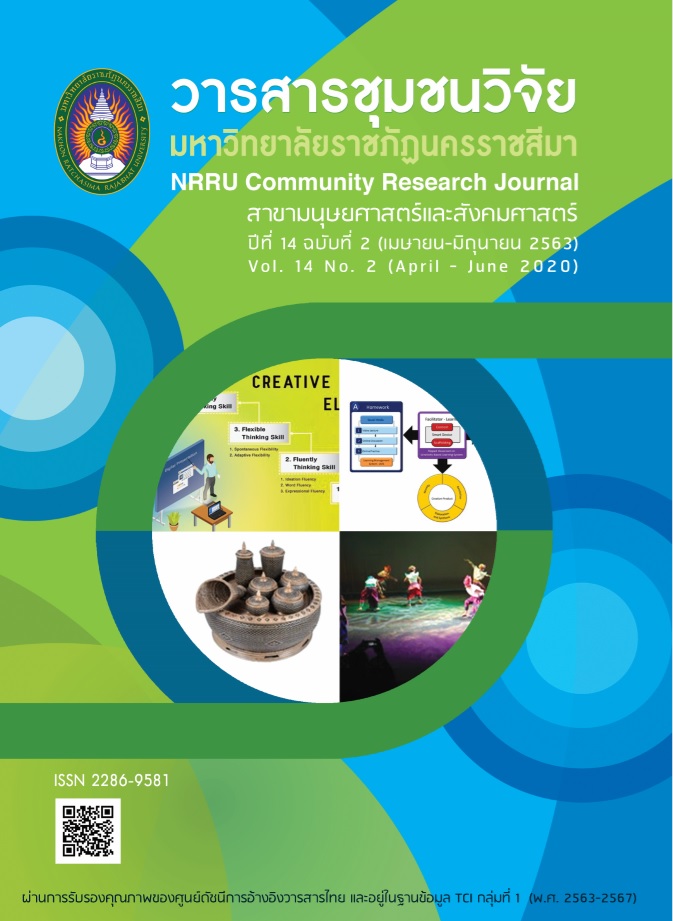FACTORS OF QUALITY OF WORK LIFE INFLUENCING WORK ENGAGEMENT OF OPERATIONAL LEVEL STAFFS IN THE ELECTRONIC INDUSTRY IN RAYONG PROVINCE
องค์ประกอบคุณภาพชีวิตในการทำงานที่มีอิทธิพลต่อความยึดมั่นผูกพันในงาน ของพนักงานระดับปฏิบัติการในอุตสาหกรรมอิเล็กทรอนิกส์ จังหวัดระยอง
DOI:
https://doi.org/10.14456/nrru-rdi.2020.23Keywords:
Quality of work life, Work engagement, Electronic industryAbstract
This research aims to examine levels of work-life quality, levels of work engagement, and the relationship between work-life quality and work engagement, that relates to the organization management in order to manage and/or issue the policy according to the employee’s work-life quality which is in turn work engagement. The stratified sampling was applied to operational staff in the Electronic Industry in Rayong province. The sample size was 370 staff. The research tool was a questionnaire, which Item Objective Congruence (IOC) was between 0.66-1.00 and reliability was 0.89. Percentage, mean, standard deviation, Pearson’s product moment correlation coefficient, and stepwise multiple regression analysis were used for data analysis.
The results showed that the work-life quality of the operational staff was at high level in overall. When consider by aspects, Career opportunities, Supervisor behavior, Work-life balance, Job characteristics, and Compensation and benefits aspects were also at high level. In overall, work engagement reaches the high level. Absorption, Vigor, and Dedication were at high level. The relationship of work-life quality factors and work engagement was at moderate to high level, which the correlation coefficients were 0.61-0.73, with statistical significance at the level of 0.05. The multiple correlation coefficient (R) was 0.82. The coefficient of determination (R2) showed the predictive power was 68.20%.
References
Avci, N. (2017). The relationship between coworker supports, quality of work life and wellbeing: an empirical study of hotel employees. International Journal of Management Economics & Business, 13(3), 577-589. http://dx.doi.org/10.17130/ijmeb.2017331328
Bank of Thailand. (2019). Business Outlook Report Q3/2019. Retrieved November 2, 2019, from https://www.bot.or.th/Thai/MonetaryPolicy/EconomicConditions/BLP/BLP_TH_Q3_2019_tf0kr6bl.pdf (in Thai)
Chapman, E. F., Sisk, F. A., Schatten, J., & Miles, E. W. (2018). Human resource development and human resource management levers for sustained competitive advantage: Combining isomorphism and differentiation. Journal of Management and Organization, 24(4), 533-550. http://dx. doi.org/10.1017/jmo.2016.37
Choochom, O. (2014). AN analysis of work engagement construct. UMT-Poly Journal, 11(2), 75-79. (in Thai)
Dechawatanapaisal, D. (2017). The mediating role of organizational embeddedness on the relationship between quality of work life and turnover. International Journal of Manpower, 38(5), 696-711.
Department of Industrial Works, Ministry of Industry. (2019). Factory information. Retrieved November 17, 2019, from http://www.diw.go.th/hawk/content.php?mode=data1search (in Thai)
Gilaninia, S. (2017). A conceptual model: The chain of quality of work life. Kuwait Chapter of the Arabian Journal of Business and Management Review, 6(5), 44-58.
I-Shuo, C. (2016). Examining the linkage between creative self-efficacy and work engagement. Baltic Journal of Management, 11(4), 516-534. http://dx.doi.org/10.1108/BJM-04-2015-0107].
Kriangchaiporn, N., & Laohavichien, U. (2019). The relationships between the level of quality of work life, Organizational commitment and the work behavior of employees at the Provincial Waterworks Authority. Rajapark Journal, 13(30), 71-82.
Labour Market Information Administration Division, Department of Employment, Ministry of Labour. (2019). Unemployment and dismissal situations. Retrieved November 2, 2019, from https://www.doe.go.th/prd/assets/upload/files/lmia_th/dd8718b6bfcf651c760fa8195cdf6e41.pdf (in Thai)
Lathabhavan, R., Senthil, A. B., & Natarajan, T. (2017). A psychometric analysis of the utrecht work engagement scale in indian banking sector. Industrial and Commercial Training, 49(6), 296-302. http://dx.doi.org/10.1108/ICT-04-2017-0031.
Likert, R. A. (1932). A technique for the measurement of attitudes. Archives of Psychology, 140, 5-53.
Pasunon, P. (2014). Sample Size Determination from Krejcie and Morgan (1970) Approach in Quantitative Research. The Journal Of Faculty Of Applied Arts, 7(2), 112-120. (in Thai)
Provincial Labour Office, Rayong Province. (2019). Rayong Labour Situation 3rd Quarter Year 2019. Retrieved December 2, 2019, from https://rayong.mol.go.th/news_group/labour_situation (in Thai)
Putra, E. D., Cho, S., & Liu, J. (2017). Extrinsic and intrinsic motivation on work engagement in the hospitality industry: Test of motivation crowding theory.Tourism and Hospitality Research, 17(2), 228-241. doi:http://dx.doi.org/10.1177/1467358415613393.
Rahmani, M., & Eghbali, A. (2018). Examining the moderating role of corporate social responsibility in the relationship between socially responsible consumption and quality of work life (QWL) of the staff in social security organization. Marketing and Branding Research, 5(1), 64-77. doi:http://dx.doi.org/10.19237/MBR.2018.01.07
Sahni, J. (2019). Role of quality of work life in determining employee engagement and organizational commitment in Telecom Industry. International Journal for Quality Research, 13(2), 285-300. doi-10.24874/IJQR13.02-03.
Schaufeli, W. B., Salanova, M., González-Roma, V., & Bakker, A. B. (2002). The measurement of engagement and burnout: A confirmative analytic approach. Journal of Happiness Studies, 3(1), 71-92.
Silpcharu, T. (2017). Research and statistical analysis with SPSS and AMOS (17th ed.). Bangkok : S.R. Printing. (in Thai)
Social Security Office. Ministry of Labour. (2020). Social security fund statistics. Retrieved November 13, 2019 from sso.go.th/wpr/main/knowledge/ข้อมูลสถิติกองทุนประกันสังคม_category_list-label_1_168_0# (In Thai)
The Office of Industrial Economics, Ministry of Industry. (2017). 10 target industries Economic drive mechanism for the future. Retrieved November 13, 2019, from http://www2. oie.go.th/publications/other (in Thai)
_______. (2019 b.). Industry Economic Situation Report September 2019. Retrieved November 2, 2019, from http://www.oie.go.th/assets /portals/1/fileups/2/files/month/industryeconomics situationreportsep2019.pdf (in Thai)
_______. (2019a.). Report of the industrial economy in the 3rd quarter of 2019 and the trend of the 4th quarter of 2019. Retrieved November 2, 2019, from http://www2.oie.go.th/ academic/industryoverview (in Thai)
Vanichbuncha, K. (2016). Statistical Analysis : Statistics for Administration and Research (16th ed.). Bangkok : Chulalongkorn University Printing House. (in Thai)





